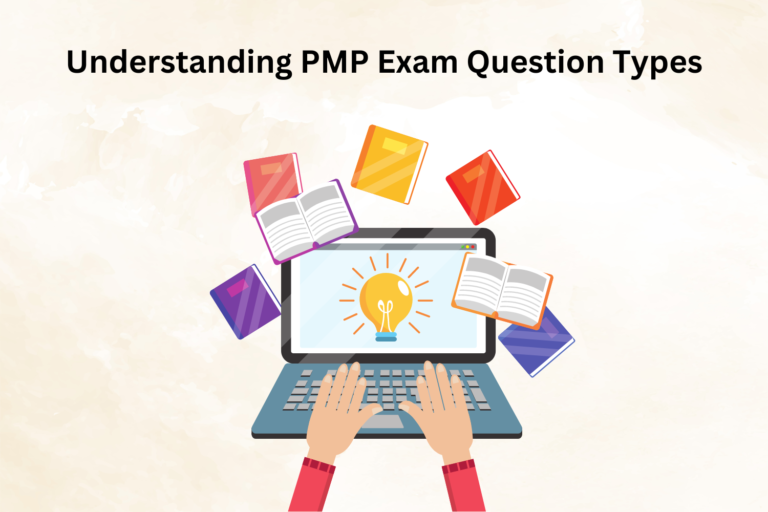
Contents
- The Project Management Professional, PMP credential is very popular in the field of project management. The PMP exam is challenging, and candidates need to prepare thoroughly. It would be helpful if you get used to the different types of test questions you can expect. You can prepare with PMP Sample Questions and understand the question pattern.
- This blog discusses the types of questions in the PMP test and offers tips on answering them.
Table Of Contents
- · PMP Exam Structure
- · Types of PMP Exam Questions
- · Conclusion
PMP Exam Structure
The PMP test has 180 questions, and you need to answer them within 230 minutes. The questions cover many project management topics, such as the PMBOK Guide. There are three main types of questions here:
- · People (42%)
- · Process (50%)
- · Business Environment (8%)
Each type of question is meant to test a different part of your project management knowledge. They can also test your ability to use that knowledge in various scenarios.
Types of PMP Exam Questions
Multiple Choice Questions
- There is a question or situation with four possible answers. Only one of the solutions is suitable or includes the correct answer.
- Example
- Which of the following processes involves defining and controlling what is included in the project?
- a) Define Scope
- b) Control Scope
- c) Validate Scope
- d) Scope Management
How to Approach
- · Read Carefully: Take your time to read the question and all possible answers. If you misread, you might get the wrong answer.
- · Eliminate Wrong Answers: Use the elimination process to discard clearly incorrect answers.
- · Think Critically: Consider the remaining options and choose the one that best fits the question.
Multiple-Response Questions
- Multiple response questions ask you to pick two or more right answers from the options provided.
- Example
- Which two processes are part of Project Integration Management? (Pick two)
- a) Develop Project Charter
- b) Define Activities
- c) Direct and Manage Project Word
- d) Monitor Risks
How to Approach
- · Understand the Requirements: Consider how many answers you must select.
- · Use Knowledge: Your choices should be based on what you know about the PMBOK Guide and how to handle projects.
- · Double-Check: Before going on, choose the correct number of answers.
Drag and Drop Questions
- Drag-and-drop questions ask you to match things, arrange steps in the right order, or group things in the right groups by dragging them to the right spot.
- Example
- Put the project management process groups with the processes that go with them.
- a. Initiating
- b. Planning
- c. Executing
- d. Monitoring and Controlling
- e. Closing
How to Approach
- · Sort Your Thoughts: Before you move things, think about how they make sense together or in what order.
- · Use Your Knowledge of Processes: Use what you know about the processes in the PMBOK Guide and where they fit.
- · Check for Completeness: Before proceeding, make sure that everything is matched or in the right place.
Hotspot Questions
- Hotspot questions present an image or diagram and ask you to click on a specific area that answers the question.
- Example
- Click on the part of the project contract discussing the project’s goal.
How to Approach
- · Learn How to Use Diagrams: Use standard project management documents and diagrams.
- · Find Important Areas: Find out where specific pieces of information are usually kept in these papers.
- · Precision: To avoid mistakes, click precisely on the area.
Fill in the Blank Questions
- In fill in the blank questions, you must give the word, phrase, or number that correctly completes a sentence.
- Example
- The process of monitoring and controlling project work involves _______.
How to Approach
- · Recall Knowledge: To complete the question correctly, use what you remember and what you know about important ideas.
- · Context Clues: Your answer should be based on the information given in the sentence.
- · Review Spelling and Accuracy: Make sure your answer is spelt correctly and makes sense.
Scenario-Based Questions
- Situation-based questions give you a detailed situation and ask you to pick the best action or answer based on project management rules.
- Example
- You are in charge of a job that is running behind schedule. First, what should you do?
- a) Crash the schedule by adding more resources
- b) Revise the project charter
- c) Perform a root cause analysis to identify the delay
- d) Update the project management plan
How to Approach
- · Analyze the Scenario: Carefully read the scenario and understand the problem.
- · Apply Principles: Figure out the best thing to do by using what you know about the methods and principles of project management.
- · Prioritise: Think about the order of activities that makes sense and set priorities based on that.
Conclusion
Knowing the different questions on the PMP test is essential if you want to do well on it. You can feel confident answering all types of questions if you know how to handle different questions. For more information visit: The Knowledge Academy.